
Amaya o los vascos en el siglo VIII is a Romantic historical novel published in 1877 and in 1879 by Francisco Navarro-Villoslada, a noted novel by a Navarrese author. The story is placed during the invasion of Visigothic Kingdom by the Moors. In line with the author's conspiracist imaginary, the story-building is permeated by anti-Semitic prejudice.

Ziortza-Bolibar is a municipality in the province of Biscay, Basque Country (Spain), in the comarca of Lea-Artibai. It has 383 inhabitants according to the 2006 census, and has an area of 18.94 km2.
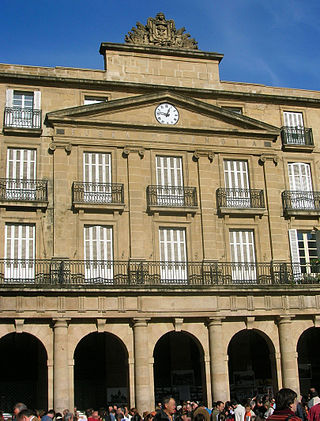
Euskaltzaindia is the official academic language regulatory institution which watches over the Basque language. It conducts research, seeks to protect the language, and establishes standards of use. It is known in Spanish as La Real Academia de la Lengua Vasca and in French as Académie de la Langue Basque.
The Basque alphabet is a Latin alphabet used to write the Basque language. It consists of 27 letters.

Soraluze (Basque) or Placencia de las Armas (Spanish), officially Soraluze-Placencia de las Armas, is a town located in the province of Gipuzkoa, in the Basque Country, Spain.

Abanto y Ciérvana-Abanto Zierbena is a municipality located in the province of Biscay, in the autonomous community of Basque Country, in the north of Spain.

Galdames is a town, valley, and municipality located in the Biscay province of the autonomous community of Basque Country, Spain.
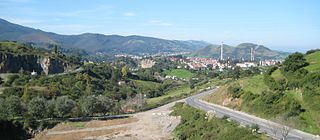
Muskiz is a town and municipality located in the province of Biscay, in the autonomous community of the Basque Country, northern Spain.

Sestao is a town and municipality of 27,296 inhabitants located in the province of Biscay, in the autonomous community of Basque Country, northern Spain. It is in the left bank of the Estuary of Bilbao and part of Bilbao's metropolitan area.
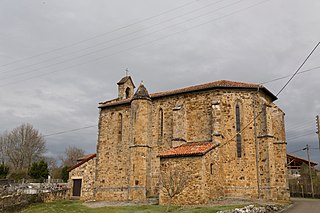
Arancou is a commune in the Pyrénées-Atlantiques department in southwestern France.

Ainharp is a commune in the Pyrénées-Atlantiques department in the Nouvelle-Aquitaine region in southwestern France.
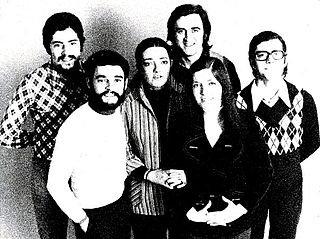
Mocedades is a Spanish singing group from the Basque Country, who represented Spain in the Eurovision Song Contest in 1973 with the hit song "Eres tú". Since June 2014, Mocedades has been the name of two bands: one with Izaskun Uranga as its leader and the other with Javier Garay. A third group, El Consorcio, is composed of former Mocedades members who left the group but have continued a career together outside the Mocedades brand.

Francisco de Garay was a Spanish Basque conquistador. He was a companion to Christopher Columbus on his second voyage to the New World and arrived in Hispaniola in 1493. Here he attracted attention when he encountered a large gold nugget worth four thousand pesos. In 1496, Miguel Diaz and Francisco de Garay found gold nuggets along the Haina River.
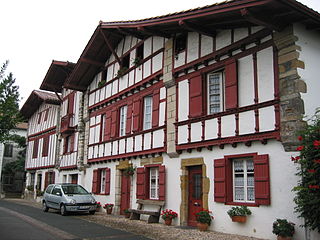
Basque surnames are surnames with Basque-language origins or a long, identifiable tradition in the Basque Country. They can be divided into two main types, patronymic and non-patronymic.

Resurrección María de Azkue was an influential Basque priest, musician, poet, writer, sailor and academic. He made several major contributions to the study of the Basque language and was the first head of the Euskaltzaindia, the Academy of the Basque Language. In spite of some justifiable criticism of an imbalance towards unusual and archaic forms and a tendency to ignore the Romance influence on Basque, he is considered one of the greatest scholars of Basque to date.

The ikurrina flag or ikurriña is a Basque symbol and the official flag of the Basque Country Autonomous Community of Spain. This flag consists of a white cross over a green saltire on a red field.

Ullíbarri-Gamboa is a hamlet and concejo located in the municipality of Arratzua-Ubarrundia, in Álava province, Basque Country, Spain.
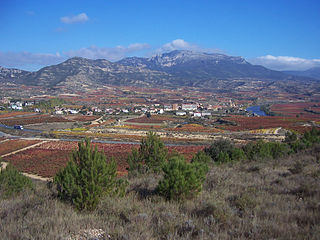
The Toloño, also known as the Sierra de Cantabria, is a mountain range in the province of Álava in the Basque Country in northern Spain.

The Asno de las Encartaciones, Basque: Enkarterriko asto, is a breed of small domestic donkey from the western part of the autonomous community of the Basque Country, in north-east Spain. It is named for the comarca of Las Encartaciones (Enkarterri), in the province of Biscay (Bizkaia). It is the only small donkey breed of Spain, and resembles the Gascon donkey, now a sub-type of the Pyrenean donkey. The Asno de las Encartaciones is critically endangered, and is protected by conservation measures.
The Villanuco de Las Encartaciones is a Spanish breed of small dog of ratter type. It originates in the comarca of Enkarterri in the Basque Autonomous Community in northern Spain. It is one of five Basque breeds of dog, the others being the Basque Shepherd Dog, the Erbi Txakur, the Pachón Navarro and the Villano de Las Encartaciones, and one of fourteen animal breeds native to the País Vasco.




















